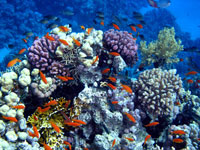 Today is Blog Action Day where bloggers around the wold are posting about a common theme – water. Most, no doubt, will be blogging about the almost a billion people in the world who do not have access to clean drinking water. This is an immediate problem which should be addressed. I have decided to blog to about another problem, not quite so immediate and not as easy to understand but still a serious threat to all of us – ocean acidification.
Today is Blog Action Day where bloggers around the wold are posting about a common theme – water. Most, no doubt, will be blogging about the almost a billion people in the world who do not have access to clean drinking water. This is an immediate problem which should be addressed. I have decided to blog to about another problem, not quite so immediate and not as easy to understand but still a serious threat to all of us – ocean acidification.
Ocean acidification is one of those terms that could easily put you to sleep or at least cause your eyes to glaze over. Nevertheless, if the scientists are correct, ocean acidification could result in the death of the worlds coral reefs by 2100. Likewise, the real threat to whales in the Southern Oceans are not Japanese whalers, but the possible widespread death of krill that are the whales food supply, due again to ocean acidification. Ocean acidification could cause a wholesale collapse of the ocean ecosystem. The effects on those us on shore would be equally disastrous.
What is ocean acidification? From the BBC:
Ocean acidification is a term used to describe the changes in the chemistry of the world’s seas, primarily as a result of burning fossil fuels. Marine scientists are concerned that changes to the oceans’ pH levels will have severe consequences for marine wildlife and ecosystems.
Since the Industrial Revolution, there has been a sharp increase in atmospheric CO2 as a result of human activity, primarily from burning fossil fuels.
The oceans have absorbed up to half of this excess CO2, which has resulted in changes in the chemistry of surface seawater.
The CO2 in the water, which leads to the formation of carbonic acid, has caused the pH of surface oceans to fall by 0.1 units, and it is projected to fall a further 0.3-0.4 pH units by the end of the century.
The shift in the waters’ chemical make-up not only increases its acidity, but reduces the availability of carbonate ions, which many creatures use to build shells and skeletons out of calcium carbonate.
The decrease in available carbonate ions means that organisms, such as plankton, coral and molluscs, struggle to build or maintain their protective or supportive structures.
